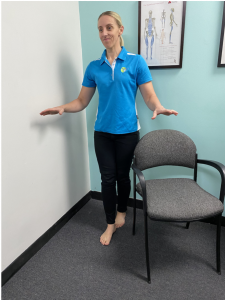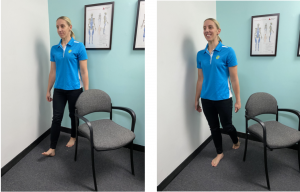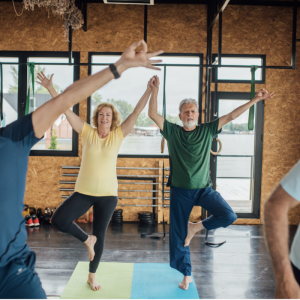Balance is a vital skill that we need to maintain our safety as well as allowing us a good quality of life.
The body uses information from your eyes, ears as well as your musculoskeletal system (joints, muscles, tendons and connective tissue). The eyes let the body know where you are in relation to the horizon, the musculoskeletal system lets your brain know what is moving and where the body is positioned.
Consistency is key when it comes to balance exercises/training! Each day is different, it is not a linear journey.
Practice your balance!
Note: please make sure you are in a safe space to practice the below balance and proprioception movements. Ideally you want to be in an

enclosed space between a wall and a chair or something else to grab onto.
Tandem stance (heel-to-toe stance)
Stand with the heel directly in front of the toes on the back foot (as if you are standing on a thin straight line)
- If this is too tricky, seperate your feet slightly
- If this is too easy whilst in this position, turn your head slowly to look at one shoulder and then the other
 Head and eye movement
Head and eye movement
- The eyes work very closely with the inner ear balance organs to give our brains information about our position and orientation. Sit down whilst completing these exercises for the first time or if you have vertigo
- Important tips: The arm should be at shoulder height and focus your vision on the tip of either a finger or thumb
Heel toe transfer (rocker)
This next exercise is dynamic, where we aim to maintain our balance whist we are moving. This exercise aims to mimic patterns and movements associated with walking, which is one of our most balance-demanding movements!
How to: Begin with toes on the front foot raised and transfer your weight forward so that the front foot flattens and the back heel lifts. Perform the movement at a slow and controlled pace. Pause for 2-3 seconds before going to the starting position
Too easy? Change to a single leg hold at the end of each position

Posture
Balance and posture are maintained by the same system within our bodies; if people have good posture, they generally have good balance and vice versa. Our body is very good at putting ourselves in a position that helps our balance the most. People that stoop and shuffle when walking often have developed that posture to compensate for their centre of gravity.
Posture is often directly related to mood. We associate feeling down with drooping shoulders and slumped trunk. Sitting tall not only helps us feel alert, it will also help open your trunk and diaphragm, making breathing a bit easier and more efficient!
Week 6 challenge: Integrate one of the balance exercises above, that is safe but challenging.

